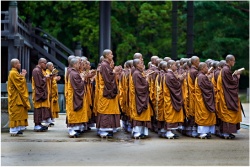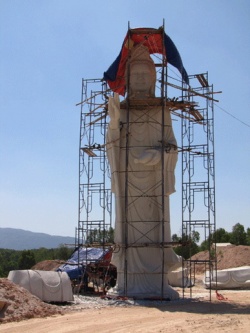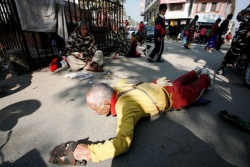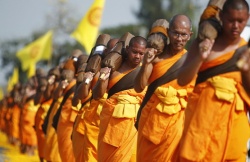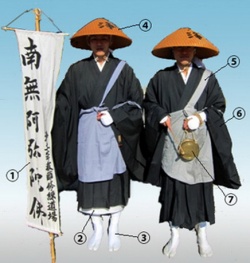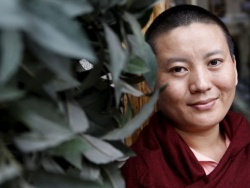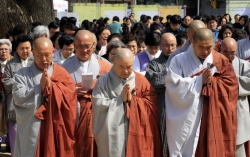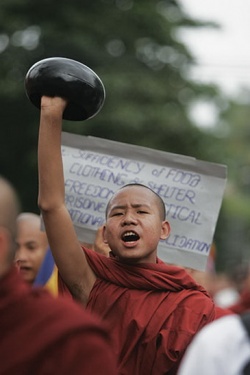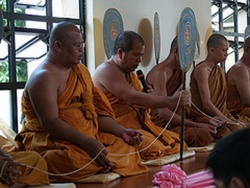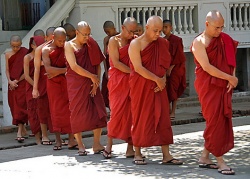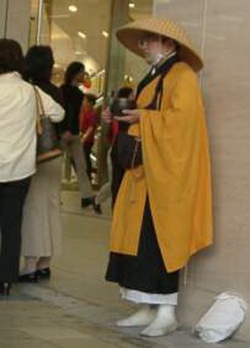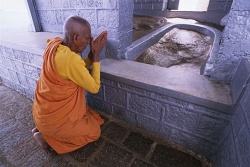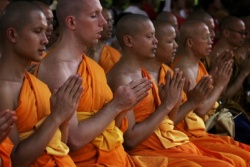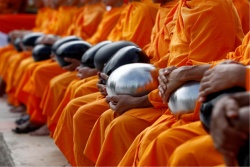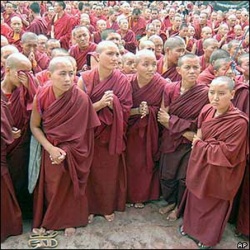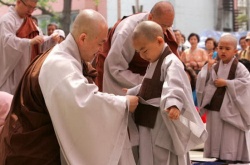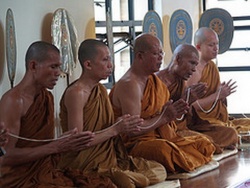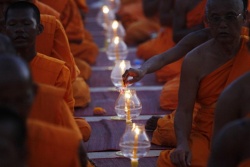The Sangha
The meaning and significance of Sangha
The Sangha forms the third component of the Triple Gem. Sangha members represent the embodiment of the Dhamma and they have been, by and large, responsible for the preservation and promotion of the religion, both during and after the time of The Buddha.
Two months after his Enlightenment The Buddha began his teaching mission by delivering the first sermon, called the Dhammacakkappavattana Sutta, to a group of five ascetics, who were his former associates. They were Kondañña, Vappa, Bhaddiya, Mahanama, and Assaji. At the conclusion of the discourse, Kondañña is said to have attained the "Eye of Truth," i.e., realized the Dhamma and achieved the first of four stages of transcendent spiritual attainment. With that, the Sangha came into being, bringing to completion the Holy Triple Gem. This happened on the full moon day of the month Asalha (eighth lunar month).
Literally, Sangha means community. In its broadest sense, the term covers both the lay and the monastic communities. From the doctrinal perspective, it refers to those who have achieved any of the four stages of transcendent spiritual attainment. Such Sangha members are known as 'noble disciples' (ariyasangha). Technically, these are called Sotapanna (Stream Enterer), Sakadagami (Once Returner), Anagami (Non-returner), and Arahanta (Worthy One). These noble disciples constitute the Sangha of the Triple Gem; they are Sangha by virtue of their special attainments. Thus anyone who has attained to that higher level is qualified to be included in this category of Sangha.
From the perspective of the Vinaya (Discipline), Sangha refers to a community of monks (bhikkhusangha), specifically a group of four or more monks, who are required to be present at certain ecclesiastical rites where a quorum of monastic members is needed. This is the Sangha according to the Vinaya definition, but not necessarily as part of the Triple Gem. Thus there are two categories of Sangha, namely, Noble Sangha and Conventional Sangha. Of course, individual monks may belong to both if they are so qualified. Kondañña and his colleagues, and many of their contemporaries, were some of these noble Monk disciples.
However, because the role of the monks is so distinct and prominent, the term Sangha is often used exclusively in reference to the community of monks and does not cover the laity as in its broader sense. In the Theravada tradition, especially, this term is never used in connection with the lay community.
When Kondañña gained the Eye of Truth, he became the first member of the Noble Sangha. When he was ordained a Monk, he became the first member of The Conventional Sangha. Thus, the conclusion of the first discourse marks the beginning of the Noble as well as The Conventional Sangha of disciples.
The position of Sangha in the Triple Gem
By realizing the Dhamma, members of the Sangha most effectively vindicate The Buddha's claim of Enlightenment, thereby bringing his supreme achievement to full fruition. The Buddha's Enlightenment was, no Doubt, the fruit of a long and difficult process, but it was meant for a much broader purpose than his own exclusive benefit; his effort was based on universal Compassion and inspired by the selfless desire to serve mankind. If there was no one to understand the Dhamma after him, his Enlightenment would be of no use to others. Thus the Sangha was instrumental in enabling Buddhahood to accomplish its full purpose and fruition. In this way, The Buddha achieved both his own benefit as well as benefit for the world.
Members of the Sangha were indispensable in the spread and preservation of The Buddha's message, both during his lifetime and long after his Death, down to the present time. They act as the principal guardians of the Faith. Without the Sangha the religion could not endure and prosper. This is evident from the fact that even in the areas where Buddhism was introduced earlier, if the Sangha were not well established, the religion would soon die out. Thanks to the Sangha, the world now has relatively convenient access to The Buddha's teachings and can still enjoy the fruit of The Buddha's Enlightenment.
The Sangha demonstrates to us that it is possible to realize the Dhamma and become enlightened. Their examples are a vivid and important source of moral support to all of us who are not yet well established in the path of spiritual practice. In time of Doubt and uncertainty, we can always turn to them for advice and instruction. If The Buddha's teachings appear too idealistic, we have assurance and encouragement in the Sangha, who show us that it is humanly possible to lead such an ideal Life and to realize the highest religious goal.
The attributes of the Noble Sangha
In Buddhist meditation there is a method of practice in which meditators learn to contemplate on the virtues of the Sangha (Sanghanussati). In addition, the Buddhist system of worship includes a recitation of the Sangha's virtues as a means of reflection and as a concentration exercise. Nine attributes of the Sangha are enumerated. The Sangha is said to be of good conduct, of upright conduct, of wise conduct, of seemly conduct; the Sangha is worthy of gifts, worthy of Hospitality, worthy of offerings, worthy of reverential salutation; the Sangha is the incomparable field of merits to the world.
Attaining one of the four stages of transcendent spirituality is a prerequisite for qualification as a member of the Noble Sangha. In fact, these four stages can be attained only in successive order starting from the first. It therefore follows that once an individual achieves the first stage, he becomes, immediately and permanently, a member of the Noble Sangha by the very virtue of that achievement. It is this very first stage that the expression Eye of Truth refers to. Subsequent attainment of the more exalted stages hardly affects one's status as a member of the Noble Sangha, although it does mean higher development and greater progress in spiritual advancement.
The four levels of Noble Sangha
The four levels of transcendent attainment may be described as follows:
1. Sotapanna. This literally means Stream Entry, a metaphorical expression suggesting a stage where one 'enters' into the stream of Nibbana. It is a spiritual sphere beyond the mundane and is therefore not liable to relapse. Once this stage is attained, the noble disciple will be inexorably swept toward the ultimate attainment of Arahantship and nothing can stand in his way. He will not be reborn more than seven times at the most before attaining Arahantship, neither will he ever be born in any woeful states (below that of human).
A Stream-Enterer is incapable of breaking The Five Precepts because he has permanently eliminated the lowest 'Fetters' from his mind. There are ten kinds of defilements called Fetters (Samyojana) that bind worldlings to Samsara or the cycle of birth and Death. Out of these ten, a Stream-Enterer has destroyed the first three, doing away with the false view of individuality (sakkayaditthi), Doubt in the Triple Gem, in the Doctrine of Kamma, and the Four Noble Truths (vicikiccha), and blind attachment to rites and rituals (silabbataparamasa). These are three of the five lower Fetters that are abandoned on the attainment of Stream-Entry.
There are three classes of Stream-Enterers: those who, if not attaining to Arahantship in this very Life, will be born only once before attaining Arahantship; those who will take only two or three births before the final deliverance; and those who will be born seven more times at the most before the ultimate realization of Nibbana. Characteristic of Stream-Enterers is their perfect moral integrity, not given to committing even a relatively insignificant immoral act, even though they may still lead the Life of householders. They have complete and unshakable Faith in the Triple Gem and would neither denounce nor renounce it at any cost.
2. Sakadagami. This is a further refinement from Stream-Entry. Literally, the term means Once-Returner, referring to the fact that a noble disciple who has attained this stage is subject to only one more birth before attaining Arahantship. This means that a Once-Returner will attain the final liberation in the very next Life if not in the present.
In addition to the three Fetters destroyed in the first stage of Stream-Entry, the Once-Returner further mitigates the Three Roots of defilements, namely, Greed, Anger, and Delusion. At this stage one has become so advanced in spiritual development that one is almost completely free from the grosser impurities (kilesa).
3. Anagami. The term is usually translated as Non-returner. This is an even higher stage of spiritual development, which the noble disciple attains on eliminating the remaining two of the five Lower Fetters (the first three have been destroyed at the attainment of Stream-Entry). These two are lust or attachment to sensual pleasure (kamaraga) and the defilement of aversion (Patigha), which causes Anger, irritation, ill will, and so on.
As a rule, because lust and Greed have been removed, a Non-returner is not inclined to remain a Householder (if he is one). He is likely to take to the Life of renunciation by entering the monastic Order, for instance, or becoming a recluse. With the destruction of lust and Anger, he is not bound to birth in any of the lower planes of existence. After Death, Non-Returners are reborn only in one of the five Abodes of the Pure (suddhavasa), where no beings other than a Non-returner are born, and from where they finally attain Nibbana.
4. Arahanta (normally spelt Arahant). This is the highest stage of spiritual attainment, which a noble disciple reaches through the complete eradication of all defilements, including the five higher Fetters, which are attachment to the realms of form (ruparaga), attachment to immaterial or formless planes of existence (aruparaga), conceit (mana), restlessness (Uddhacca), and Ignorance or Delusion (Avijja). An Arahant, or Worthy One, is said to have accomplished what needs to be accomplished: being perfect, the Arahant has no further need to practice for his own sake. Although continuing to serve fellow beings, teaching and giving them advice, the Arahant accumulates no fresh Kamma, working not for his or her own good but solely for the good of others. Being free from all kinds of defilements, the Arahant lives in perfect calm and Equanimity, not given to such negative emotions as lust, Greed, jealousy, Anger, and aggression. The Arahant becomes one with The Buddha in purity of Heart, in Wisdom and Compassion. This is the ultimate achievement, the highest spiritual development any individual may strive for. It is the same state which The Buddha attained in his Enlightenment.
The Worthy One transcends the conditions of birth and Death. At the final moment of his present Life, he is said to pass away "like an oil lamp being extinguished," with no residue of Kamma remaining to cause further Rebirth. He lives a useful Life, dedicating himself to the service of mankind, yet he is not attached (in the sense of selfish grasping) to blame and praise, Happiness or unhappiness. In this way he truly represents the ideals of a holy Life.
Two kinds of Sangha
The term Dhamma-Vinaya, used by The Buddha in reference to the religion he established, represents the two aspects of The Buddha's teachings, and these two aspects of The Buddha's teachings are the basic underlying principles for the two kinds of Sangha.
Vinaya or monastic discipline is said to be the mainstay of the religion (vinayo sasanassa ayu). It is the principle on which the existence, the stability, and the development of The Conventional Sangha rest. A man, for instance, is admitted into membership of the monastic Order or Conventional Sangha through an ordination process prescribed by the Vinaya. He lives by the Vinaya rules. The Vinaya regulates his conduct both in regard to himself and in his interaction with others. His Dhamma practice is almost considered an extension of his effort to train according to the Vinaya, not a separate exercise in itself, and it is always kept in line with the Vinaya rules.
Thus the Life of a Conventional Sangha member is essentially dependent upon the Vinaya. Obviously, this is also true of the Sangha as a community. Without the Vinaya, the whole structure of Conventional Sangha would collapse. It is in this sense that, according to Theravada Buddhism, the Vinaya is said to provide the mainstay for the religion.
The Dhamma, on the other hand, is the Life and soul of the Noble Sangha, its essence, its inner quality. Just as Kondañña entered into membership of the Noble Sangha through the realization of Dhamma, even so the existence of the Noble Sangha must necessarily rest on the Dhamma. Unlike Vinaya, the Dhamma has little to do with institutional or ceremonial procedures, although such things may provide a basic framework or support for its realization. The Dhamma also has a much broader application than the Vinaya and is equally important for both monks and the lay community. It places no restrictions with regard to individual status. Like monks, lay people may practice the Dhamma and achieve, on their own virtue, admission into the Noble Sangha. This is purely a matter of personal training and self-development.
It is interesting to observe that, in response to a question whether there were noble disciples among the laity, The Buddha asserted that the number of his noble lay disciples was greater than that of monks. This very well demonstrates the universality of the Dhamma and how much opportunity is open to all seekers of the Truth to practice it. Of course, the monastic setting, with the disciplinary codes of conduct, provides an excellent ground for the cultivation of the Dhamma, especially for those who would otherwise find it difficult to practice or for practitioners whose temperaments favor a more structured environment. In fact, on a deeper level there exists a close link between these two aspects of The Buddha's teachings. The practice of the Vinaya facilitates progress in the Dhamma training, while progress in the Dhamma helps to put one at ease with the Vinaya. They are, so to say, two sides of the one coin.
Relationship between the Noble and Conventional Sanghas
Like the Dhamma and the Vinaya, the Noble and the Conventional Sanghas do not exclude one another. They are, in fact, more related to one another than may appear at first glance.
Within the framework of The Conventional Sangha, the Vinaya defines the roles and responsibilities of each member and also decides how members relate to one another. Respect is shown to another Monk in accordance with seniority -- those who were ordained later pay respect to those who received earlier ordination, even if it were a matter of hours or minutes. A Monk of less than five years seniority, no matter how knowledgeable he may be, will have to live and train under his preceptor's or teacher's supervision. But within the Noble Sangha, recognition is given according to individuals' achievements in spiritual practice. An Arahant, though of younger age and seniority, receives greater respect and recognition than those worldlings (puthujjana), who are more advanced in age and seniority; a Non-returner is considered more advanced than a Once-Returner in terms of spiritual achievement, and so forth.
However, since The Conventional Sangha is an institution, which must be governed by a defined set of rules and regulations, the Vinaya naturally takes precedence within it. The Vinaya provides a certain amount of Consistency necessary for the smooth functioning and growth of the institution. It also helps to preserve peace and Harmony among the members of the community. Thus a member of the Noble Sangha living within the context of The Conventional Sangha takes upon himself the responsibility of following the injunctions of the Vinaya, no matter how exalted his spiritual position may be. This may seem a little strange, but it is both practical and appropriate.
The Conventional Sangha, on the other hand, can look upon the Noble Sangha as the embodiment of virtues and religious ideals, whose presence provides a strong inspiration and encouragement for them to strive for the attainment of higher goals. The structured environments so well-grounded on the Vinaya should prove an advantage to Dhamma practice. Even members of the Noble Sangha who have not attained Arahantship may benefit from such environments. Moreover, while The Conventional Sangha is capable of creating excellent conditions to achieve membership in the Noble Sangha, it is the latter that will prove excellent members of the former and may, eventually, best preserve the institution of the former. In this way, the Noble and the Conventional Sanghas complement one other.
Dhamma and Vinaya are reciprocally complementary and supportive. Just as a good person, well-educated and in high position, would endeavor to abide by the laws of the country, even so, advancement in the Dhamma by no means nurtures a contempt for the Vinaya. A noble disciple, though advanced in the Dhamma, recognizes the importance of the Vinaya in religious Life. Because he has been able to remove most or all of the defilements, it becomes more natural for him to show respect for rules and regulations that are formulated for the common good of the community. Thus, whereas ordinary worldlings, who are still full of selfishness, Greed, and pride, would at times find rules and laws cumbersome, especially when they are at variance with their interests, a noble disciple would feel at home with them.
In addition to preserving communal peace and Harmony, the Vinaya is also of great value in the practice to realize the Dhamma. Progress in spiritual practice is not possible without self-discipline, and this can be inculcated through commitment to the Vinaya. On the other hand, as one becomes more advanced in the Dhamma, one will find it more natural to follow the Vinaya. In this way the Dhamma helps to maintain the Vinaya. Once a noble disciple reaches the highest stage of spiritual development, that is, Arahantship, and has no more training to do, he may no longer need the Vinaya for his own further progress, yet he will discern its value for the good of the community and will be willing to follow it with clear understanding and respect. There is abundant evidence to substantiate this in Buddhist canonical literature.
Historical changes within the Sangha
When Buddhism was first established, there were only Arahant disciples. The first group of sixty monks who spent the first rains residence (vassa) with The Buddha were all Arahants, and so were the more than one thousand disciples whom he taught on his way to the city of Rajagaha. It is said that on the full moon of the month of Magha, barely seven months after he delivered the first discourse, a total of 1,250 Monk disciples, who were directly ordained by him, assembled at the Bamboo Grove to see the Blessed One. They were also all Arahants.
To such highly accomplished disciples, The Buddha enjoined but one task: "Go forth, monks, for the welfare of the many, for the Happiness of the many, out of Compassion for the world, for the good, the benefit, and bliss of gods and men." The Buddha further said: "Released have you been from bondage, both human and divine. Teach, therefore, to the world the good Dhamma, which is beautiful in the beginning, beautiful in the middle, beautiful at the end." This was the mandate given by The Buddha for his disciples to carry the message of Dhamma to the masses, and it remains the driving principle underlying the Buddhist social philosophy even today.
Teachings given by The Buddha's noble disciples were most readily accepted. These disciples of The Buddha represented an ideal of spiritual training, demonstrating how a Life of Dhamma should be lived and how the ultimate Enlightenment can be achieved. Thanks partly to the efforts and dedication of these disciples, who were mostly monastic members, the religion of The Buddha became well established within a relatively short time.
For those monks who are not as yet fully enlightened there are two main duties to be carried out. The first is the duty of scriptural learning (ganthadhura), which familiarizes students with the Doctrine and the discipline laid down by The Buddha, and gives them a proper direction and methodology for spiritual practice. The other duty is the training in meditation (vipassanadhura), which is the practical aspect of the higher religious Life. Of course, even in the time of The Buddha, certain highly developed monks would engage themselves in scriptural learning, if only to help preserve The Buddha's words, just as they would engage in meditative exercises to experience the bliss of Nibbana.
The institution of Sangha came into existence in response to the growing number of monks who came to join the Order. Definite structure took shape over the years. The primary function of the Sangha institution in its early days was to provide an ideal setting for the practice of Dhamma, where more energetic members could derive the benefits of moral support and instruction from good associates. Without such benefits the Sangha would be much less meaningful to the religious Life it was originally intended to serve.
With the passage of time the role of the Sangha has expanded more and more into social concerns. Not only do monks teach Dhamma, they also perform ceremonies for the laity, especially at important events connected with Life (such as births, weddings, and deaths). Their counsel is sought in family or communal disputes, their presence is considered auspicious at the opening ceremony of a new business, they are requested to bless a new house, a new office, or even a new car. In early Thailand, not only were monasteries seats of religious learning, even secular subjects were taught there until just before the introduction of the modern education system. Monks represented not only spiritual leadership in religious affairs, but also intellectual leadership in society, for they were usually the best educated sector of society. Because of the trust and confidence the community places in them, they are also looked up to for leadership in certain communal activities, especially in rural areas, where monks and laity enjoy closer bond and cooperation.
Monks' roles in society often reflect people's needs and their expectation of the Sangha institution. But foremost of all duties they are expected to fulfill are the two duties of scriptural learning and training in meditation.
Sangha and social work
The primary obligation of most novices and younger monks is to equip themselves for future religious assignments. This is only natural. If we do not expect young people studying in schools, colleges, and universities to shoulder heavy social responsibilities, it would be unfair to expect Monk students to accomplish much when they are not yet well-equipped. Moreover, even while engaged in educational pursuits, the tasks and responsibilities these novices and young monks have to undertake are much more onerous than those of their lay counterparts. Not only do they study religious subjects, in which they specialize, they also have to study suitable secular subjects to supplement their religious knowledge in view of the duties they are expected to perform later on. In addition to this daunting challenge, they also have to work hard for "the welfare of the many, for the Happiness of the many, out of Compassion for the world." Because of their religious status, people always have high expectations and look up to them to fulfill those expectations. This is by no means an easy role and it often puts a considerable pressure on young monks.
Monks who are not burdened with educational careers do take an active part in religious and social concerns, especially if they are senior members of the Sangha. In fact, their responsibilities increase with age and seniority. At an age when most laymen would retire to enjoy their leisure, these elderly monks have to meet the increased expectations and demands that people have of them. Often they work hard until their last Breath or until they become completely invalid, so great is their spirit of self-sacrifice and dedication. One of the reasons why this is not widely known to the public is because these selfless monks would rather keep to the tradition of silent service, quietly working for the benefit of others, than working to gain personal benefits and Fame. Nevertheless, the fact remains that the social contributions made by the Sangha are, indeed, of inestimable value.
Today the monks' social roles are more visible in the rural areas or villages, where the bond between the Sangha and laity is still relatively unaffected by the urban culture and patterns of behavior. Poor villagers often turn to monks to mediate land disputes, family problems, and differences among neighbors. Unruly and stubborn children are taken to a monastery for training in discipline and other social values; sometimes boys are even ordained for that purpose. The village monastery also functions as the center of social activities, where most communal affairs take place. When and where necessary, monks take initiative in various social projects, mainly by giving guidance and leadership, such as construction of schools and hospitals, roads and small reservoirs, and at times even the digging of a village well. They also take leadership in raising funds for such projects. In times of natural calamity there have been instances in which monks provided the most effective leadership in pooling resources together to help ameliorate the Suffering of victims and their families.
Even forest monks, who are known for their natural inclination for meditation and solitude and who spend most of their lives in forests, contribute valuable services to society. They are looked upon with great respect and their counsel is sought after. They are either directly or, more often, indirectly instrumental in setting up charitable programs or foundations for the welfare of society. They help preserve the forests and water resources of the country. In most cases their influence and intervention in such matters prove more effective than those of government agencies. Again little or no efforts have been made to publicize their achievements and social contributions and a wider section of the public remains unaware of the fact.
In modern Thai society, although the new educational system has come to replace the traditional one, school facilities are often found located on monastic property donated by the Sangha. In addition to their assistance in raising funds for construction, monks also contribute their teaching skills in a number of those establishments. Naturally, monastery grounds where school facilities are located are often turned into playgrounds for the children. Noise and mischief spill into monastic environments. Good-naturedly, the monks put up with them and watch the children grow to become good and useful members of society.
Qualifications for ordination
In the Theravada tradition, ordination as a nun (Bhikkhuni) is no more available, but many women do receive religious vows and lead a monastic Life akin to monks. They are often referred to as nuns. In Thailand most of these nuns dress in white (a few in dark brown) and are no less active than monks in religious and social activities. In Myanmar the usual color is very close to pink, while in Sri Lanka it is either yellow or saffron.
For male candidates there are two levels of ordination, the lower and the higher. A boy under twenty may request lower ordination and those who are twenty or more may request the higher one. Of course, those who are qualified for higher ordination, if they so desire, may request the lower one and remain in that position for as long as they wish, though that is not commonly practiced.
A candidate for ordination must be physically fit, not handicapped or mentally defective. He must be in good health, physically as well as mentally. He must be free from contagious diseases such as leprosy, eczema, chloasma, and other dangerous chronic diseases such as epilepsy. Although venereal diseases and AIDS have not been mentioned in the Books of Discipline for obvious reasons, it is not unreasonable to assume that they do constitute a strong ground for rejection. Moreover, the candidate must have his parents' permission to be ordained, must have the king's permission, i.e., not bounded by government services, having duly taken leave, must be free of debt, and must be in possession of a bowl (for containing Food) and a complete set of three robes.
The candidate desirous of ordination should be presented to the abbot of the monastery where he would like his ordination to take place by his parents or some of his senior relatives. He will be duly interviewed by the Monk and, if found eligible, will be admitted to the monastery for preparatory training. Before the date of ordination he is expected to have mastered basic monastic rules and regulations as laid down by The Buddha and some fundamental knowledge in the Dhamma. The preceptor will also teach him monastic protocol and how he should conduct himself as a Monk.
Questions about costs are usually a concern among Westerners, who are not accustomed to free services so common in the East, especially when religious matters are concerned. As a rule, services rendered by Buddhist monks or monasteries are without charge. The monasteries even provide free residential facilities. The only expenditure that is really needed for the ordination ceremony is that for the robes and bowl. A Monk's Life is meant to be austere, so there should be nothing other than what is needed for simple subsistence. Should the candidate find it difficult even to supply himself with those few items, the monastery may give him necessary support so as to enable him to fulfill his noble aspiration. Traditionally, The Buddha allowed only eight articles for monks' personal use. These are three robes, a (Food) bowl, a razor, a needle, a cloth belt, and a water filter. Things other than these eight must be subjected to collective ownership of the whole monastic community to be distributed properly to needy members.
To receive ordination the candidate must first have his head shaved clean. This symbolizes his departure from the Household life to homelessness. According to the Vinaya, a higher ordination ceremony may take place only in a specific building or area called Uposatha (the main chapel) of the monastery, which must be duly marked in all directions by boundary stones or some other solid objects. At least five monks must be present, including one who will act as the preceptor. In regions where monks are easily available, such as big cities, at least ten monks are required. The common practice in Thailand is to invite twenty monks to take part in the ceremony.
First the candidate approaches the monks, already assembled in the main chapel, with a set of robes and other requisites, accompanied by parents, relatives, and friends. Heading the chapter of monks present is the preceptor, usually the most senior and best qualified in the monastery. Sometimes a preceptor may be invited from another monastery to officiate over the ordination ceremony, if the candidate or his relatives so desire. Having approached the assembly of monks, the candidate prostrates before the preceptor and makes a formal request for ordination by reciting three times the Pali request passage. At the end of the recitation, he hands the set of robes over to his preceptor, who then proceeds to examine them to ascertain if they are proper for use.
Satisfied with the robes, the preceptor gives the candidate appropriate instruction concerning the Life of a Monk. He also explains some basic methods in meditation that involve contemplation on the impermanent and unsatisfactory nature of the five bodily objects: Hair on the head, Hair on the Body, nails, teeth, and skin. Then he allows the candidate to put on the robes, assisted by one or two of the monks present. After putting on the robes the candidate again prostrates before his preceptor, or another senior Monk appointed by him, and makes a request for the ten precepts of a novice. Part of this process involves going for Refuge to the Triple Gem, at the conclusion of which the candidate is pronounced a novice (Samanera). Then the new novice receives the ten precepts. The end of this precept administration marks the completion of the lower ordination ceremony.
The higher ordination ceremony continues from this point. The candidate makes a request for higher ordination to the Sangha by reciting the request passage three times. Thereupon, one or two monks (usually two) will be sanctioned by the Sangha present to question the candidate, who is now a novice, to ascertain his eligibility and readiness for monkhood. Special care is taken to ensure that the candidate is completely free from any conditions that would disqualify his entry into the monastic membership. This session is supposed to be carried out in private to allow total freedom for the interview, which therefore must be done outside the assembly. After questioning and being satisfied that the candidate is suitable for admission into the Sangha, the interviewers return to report their findings to the preceptor and other Sangha members.
After a proper consultation among the Sangha, the candidate is called into the assembly for cross-examination in their presence. The Sangha having been convinced of his eligibility, a motion is then proposed to the Sangha on the candidate's behalf requesting his admission into the institution. This motion is repeated three times to allow sufficient time for all the Sangha members to deliberate and raise objection should any of them feel strongly against the motion. Each Sangha member has equal right to vote for or against the candidate's proposed admission and a single objection would suffice to nullify the whole endeavor. In the absence of an objection, the motion will be pronounced carried, and the novice accepted as a member of the Sangha. From this point onward, the novice is elevated to the status of a fully-fledged Monk, with all the duties and responsibilities of a Sangha member.
Before declaring the ceremony closed, the preceptor performs his last duty. He congratulates the new Monk and gives him suitable instruction, especially that which concerns the most essential practice and rules of a monastic Life. The ceremony usually concludes with the new Monk performing an act of transferring merits to ancestors, parents, friends, well-wishers, and all other Sentient beings. After that, relatives and other devotees make offerings to the new Monk.
The whole procedure is conducted in the Pali Language, except the instruction which the preceptor gives to the candidate at the beginning and the end of the ceremony.
Daily Life of a Monk
The monastic Life-style is very different from that of the laity. It is designed to be conducive to spiritual practice and suitable for a Life of dedication and service. As such it has to be kept simple. It should also be free from family concerns and obligations. Whereas wealth is considered a symbol of success and social status, it is an impediment on the spiritual path, especially as far as monks are concerned. Monks' daily routines are also markedly different from those of lay people.
A Monk's day begins in some monasteries as early as 3 a.m. By four most monks have already arisen. The predawn hours are devoted to meditation, Chanting, and scriptural studies. At daybreak, the monks walk the streets on alms round to receive Food offerings from devotees. Monks in villages usually walk long distances, as houses there are few and far between. According to the Vinaya, monks may eat only between daybreak and midday, not before or after that. Some monks eat only one meal a day, others take breakfast and lunch, but all finish their last meal before midday.
Those monks who are engaged in educational activities spend the morning and afternoon sessions in educational pursuits, either teaching or studying as the case may be. Understandably, more educational facilities are found in urban areas or big cities. Some monasteries confine their curricula to religious subjects, such as those prescribed by ecclesiastical boards of education, others providing facilities for suitable secular subjects as well. Some monastic establishments specialize in Abhidhamma, which represents the metaphysical aspects of The Buddha's teachings.
Monks living in meditation centers spend a good part of their time each day on meditative practices. Late afternoon session is normally reserved for collective manual labor, where all monastic inmates, monks or lay practitioners, join hands to fulfill their monastic chores, such as sweeping the compounds, cleaning the main chapel, drawing water from the well, etc. Those who live in community monasteries are also prone to engage in social welfare activities; they teach in schools, give counsel, or visit the sick. They are also often invited to perform ceremonies in houses or at business establishments. More gifted monks may write Books, or give lectures at universities.
Normally, there are two services of worship each day, morning and evening. Morning services may be conducted either in the early dawn or after breakfast, evening services take place around the early hours of the evening. As a rule, in forest monasteries, where special emphasis is on meditation, morning services are conducted in the early hours of dawn, e.g. around 3:30 or 4:00, and evening services begin around 7:00 or 7:30. These services consist mainly of Chanting and a period of sitting meditation. Occasionally, senior monks give instruction and long discourses on the Dhamma or meditation. Shorter discourses are more regular. Those monks who are as yet students devote the night hours to scriptural learning and homework. By the time they retire, it is already late in the night.
Monasteries in Thailand are in a perpetual process of building, expansion, and renovation and it is not uncommon to see construction activities going on at any time of the year, even in monasteries which have been founded for decades. In many instances, construction labor comes from monks and novices living in the monasteries themselves, particularly those in villages. The monks are thus kept busy all year round.
Though the monks' Life is simple, it is never idle. With all the duties and responsibilities they are expected to fulfill, both as individual members of the Sangha and as spiritual leaders of the community, monks exemplify the spirit of The Buddha's mandate by dedicating themselves to the welfare and Happiness of the world.
Shaving the head
The shaving of the Hair symbolizes renunciation and marks one's departure from the worldly Life. This is clearly one of the most striking physical distinctions between a Monk and a Householder, indicating the Monk's changed status. Since monastic Life is meant to be simple and burden-free, shaving the head helps to realize that objective. Hair is an object of vanity and pride, qualities that are not supportive of spiritual practice. Thus monks are advised to shave and keep the Hair short. In Thailand monks and novices all over the country keep to the tradition of shaving their heads on the same day of every lunar month, on the full moon eve. This tradition is not observed in other Theravada countries, although the practice of shaving and keeping the Hair short is commonly followed by all monks -- Theravada, Mahayana, and Vajrayana -- the world over.
Since shaving strongly represents the values of a religious Life, monks and novices are encouraged to meditate, during the tonsure, on the transitory and unsatisfactory nature of the Hair. They are also reminded to reflect on the duties and responsibilities that a religious Life, so vividly symbolized by the cut Hair, has enjoined on them. There are reports of some spiritually advanced disciples during The Buddha's time who attained Arahantship while shaving. Thus, the simple act can be used as a means to attain higher and nobler objectives.
Like the Hair, monks' robes are also meant to reflect the simplicity and austerity of religious Life. In the earlier part of The Buddha's mission, when the number of monks was relatively small, the only way that a Monk could get a robe was by collecting castaway pieces of cloth, wherever they could be found. These were thoroughly cleaned, boiled, dyed, and stitched together to make a larger piece, sufficient for the purpose. It was the intention of The Buddha not to create burdens for the lay community by asking for their support in this regard. Even the dye was obtained by boiling down suitable wood or bark. The Buddha wanted monks to be as self-sufficient as possible and learn to be content with little (appicchata). A Monk is expected to keep only three main robes at a time as part of his eight requisites; these robes consisting of an under robe, an upper robe, and an outer robe. They are simply cloths of rectangular shape, made up from many smaller pieces, and the pattern of stitching "following the pattern of the Magadha paddy fields" has been maintained down to the present, even when textiles are available in abundance. This explains why monks' robes have the patchy appearance they do today.
The color of the monks' robes is brownish yellow, although the shades may differ. Forest monks are often distinguished by the darker shade of their robes, but some monks living in villages or cities may also use similar color (although their usual tone is a lighter one).
Monastic rule
There are ten principal precepts and seventy-five minor rules for novices (those of lower ordination), and these rules define how they should conduct themselves in matters concerning the use of their robes and proper social etiquette, how Food should be accepted and consumed, the manner in which a discourse should be delivered, and miscellaneous behavioral expressions.
For a fully-fledged Monk there are much more numerous rules and regulations. Most important are the 227 rules that are contained in a book called Patimokkha. Of these 227 rules and regulations, four are the most serious, transgression of them resulting in permanent expulsion from the Sangha. Others are considered 'redeemables.' Monks who have committed a redeemable disciplinary breach are required to confess to the Sangha, a group of monks, or an individual Monk. Thirteen of these redeemable offenses necessitate a period of probation, during which the offender undergoes a meditative retreat and engages in a process of self-examination, before he will be considered for readmission by a panel of no less than twenty Sangha members.
Theravada Buddhism endeavors to preserve all the Vinaya rules and regulations exactly as they were laid down by The Buddha more than twenty-five centuries ago, neither adding any new ones nor rejecting the existing ones. This decision was taken at the First Buddhist Council, held three months after The Buddha passed away, and it is still honored today. Of course, individual monasteries may enforce rules and regulations of their own, but such measures must not conflict with the Vinaya. Moreover, they may be subjected to alteration or modification from time to time, but the Vinaya will always remain untouched and unchanged. This is the true spirit of the Theravada tradition.
